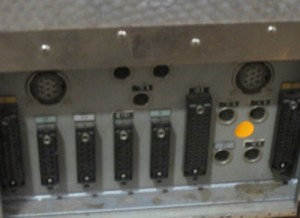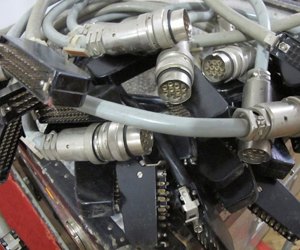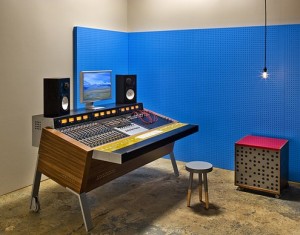To Mock the Stupendous Mechanism: The Story of The Motherbrain’s WSW Console
How producer and studio owner Brian Bender turned a time capsule into a modern-day tone machine. Click to read the first part of the series.
Part 2 — Fact Finding
So, a console. Or rather, a pile. The first thing I did when I got word about this desk was naturally get online and do as much research as I could. Surprisingly enough, early research proved extremely fruitful and I stumbled upon http://www.wsw.cz a Czech fansite about a long dead Austrian electronics company. I love nerds.
Not only did wsw.cz have almost all the schematic documentation I needed, scanned legibly, the person who curates this website even has scans of original product sheets from WSW. We now had factory THD+N specs, pin outs, even graphs of the EQ curves. I can’t even find this shit for most modern gear.
The catch? The site is in Czech and the docs are all in German. Yea.
So after several days of head scratching and a crash course in technical German thanks to Google Translate, Jon and I had enough information to get inside the modules and start figuring out what was what.
I’ve had many experiences dealing with the ol’ pile-of -console and so I wasn’t too put off by the idea of trying to figure out how humpty dumpty went together but, even if we were able to deduce how all the boxes fit together, it wouldn’t make much sense to set up those pop metal boxes in the control room and start making records.
Moreover, the sort of overarching ethos of design in the studio here has been based on modularity. After closing so many rooms, I have been more than a little reticent to dig in with a few hundred pounds of metal that can’t go into a wheeled rack case.
However, I cut my teeth on big desks. The SSL E/G that used to live at Looking Glass Studios was a very, very dear friend and I’ve spent many a hundred hour week on the J at Studio C in Electric Lady. I love working on a well-maintained console.
I will say though (and this is as a tube-loving luddite), that so much of the functionality of large format consoles, while super rad and totally a point of pride for their owners and end users, is horribly redundant at this particular point in history. Your DAW of choice probably has a better and more flexible automation system than whatever console of your fancy. Moreover, you never have to clean the busses in Pro Tools with a toothbrush.
The option that ended up making the most sense for me when I went full time freelance a few years back was a summing mixer. It’s the best of both worlds, really, but that’s a desecrated horse corpse, well-beaten, that I won’t further flagellate here.
I ended up building a 24 ch. Tonelux, which I adore. Paul Wolff, formerly of API, designed and built these modules and I colloquially refer to it as my baby J series. It can be bad-jazz-record clean or will faithfully reproduce the grimiest of overdrives and is slightly Hollywood on top. It’s modular and scalable which is incredibly useful for a freelancer such as myself.
The implementation of their fader automation system is truly genius. (Seriously, check it out if you’ve not already. Genius.) And mine, as configured currently, is 6U. RAD. Recalls are as easy as regularly aligning the thing with tone and pulling up outboard settings. There is no way I would even consider scrapping my Tonelux and so I began to look into interfacing the two.

Detail of the original WSW I/O. (These collectively handle power, audio, buss linking, even sharing the tone generator across the desk.)
One thing that really links the two desks is their modularity: Tonelux has a rack standard à la the 500 series standard, and modules can be added or subtracted easily as bread availability for growth, or tech requirements dictate. Similarly, the WSW modules take all the audio I/O and power simply on three amphenol connectors on the back of the subframe.
These WSW units also have direct outs already so no modifications on a circuit level are required to get 1 in 1 out functionality. We aren’t required to submix to get audio out of the thing.
This obviously makes the entire desk far more useful for anyone’s purposes. The mic pres become a thing. Hardware Inserts for EQ become a thing if you need post fader/post EQ automation, etc. Now, with the addition of some specially purposed Tonelux input modules, we will be summing the entire mix buss through the Tonelux rather than submixing and bringing in the WSW side on a stereo pair.
So then, the real question became how best to do all that. It seemed like trying to rebuild the mess in the racks as delivered was a kind of moot point if the real endgame is to have all the direct outs in the patchbay. This way, the analog routing options begin to approach the flexibility of their digital brethren.
In the configuration we’re planning, the Line Inputs will be normalled from Pro Tools outs. Their direct outs will then show in the patchbay, normalled into the inputs for the Tonelux FX 2 modules that get them into the Mix Buss. For tracking, the desk can function easily as spilt console with a simple cross patch to get the WSW outputs into Pro Tools instead.
So we began to look into housing options that could accommodate both the Tonelux half and the WSW half.
My good friend Christian Rutledge then pointed me in the direction of the work Allen Farmelo and Francois Chambard had just done on his custom API. I reached out to Allen and the rabbit hole began to quickly deepen.
Next up: Wherein Hal 2000 meets Jude Law and they build the Death Star
Brian Bender has enjoyed the pleasure of running sessions at Looking Glass, The Hit Factory, Electric Lady and many more beautiful rooms in New York and beyond. His co-conspirators include names as diverse as Philip Glass, The Counting Crows, Al Green. Borusan Philarmonie and Craig Street. Recent clients include Krystle Warren and the Faculty, Sister Sparrow and the Dirty Birds, Jose James and Langhorne Slim.
Please note: When you buy products through links on this page, we may earn an affiliate commission.










Kevin D. Reilly
February 2, 2012 at 5:01 pm (13 years ago)never worked on a spilt console…doesn’t that let the magic smoke out?